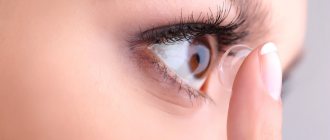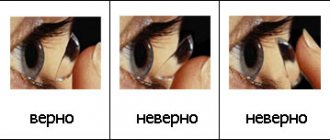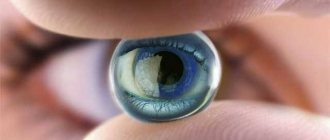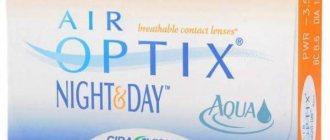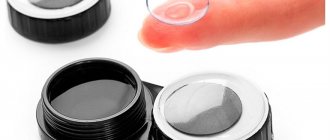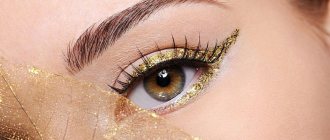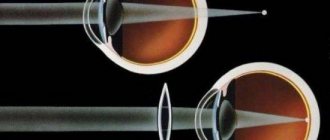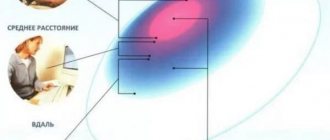Long term lenses
They are ideal for travel, night work, day work. Suitable for people who forget or do not want to constantly remove products at night.
They are presented in the following types:
- two weeks;
- period;
- three months;
- six months.
These deadlines are maximum. They are indicated on the lens packaging. Depends on the material, technology, additional properties. It is recommended to take breaks. Periodically remove lenses at night to rest your eyes and clean the products. Two-week lenses are used for increased sensitivity. Well-known companies are Johnson&Johnson, Alcon, Bausch+Lomb.
No less popular are products for 30 days of wear, 3 months. They are the most economical.
CLs for 6 months are practically not issued for a number of reasons. The most significant is insufficient provision of comfort and hygiene of the organ of vision. Infectious and inflammatory eye diseases – blepharitis, conjunctivitis – may occur. Serious pathologies of the cornea are not uncommon, including loss of vision if operating instructions are not followed.
When using continuous wear contact lenses, follow 2 rules:
- Change the contact lens before the end of the wearing period. This will prevent the development of complications, inflammation, and infections.
- Periodically remove your lenses at night by placing them in a special cleaning solution.
Pay attention to the best long-term contact lenses.
The disadvantage of the Biofinity (USA) brand is its high cost. Silicone hydrogel is used for production, eliminating the use of special moisturizing agents. The maximum time of continuous use is 7 days, and you can wear it for a week without taking it off, or during the day and rest your eyes at night.
The advantage of the model is its high level of breathability, which ensures comfortable use without the development of complications. Oxygen continuously flows to the cornea of the eye, preventing the development of hypoxia. In addition to correcting farsightedness and myopia, lenses from this concern correct astigmatism and age-related presbyopia.
British optical products Maxima 55 are of the hydrogel type, partially protecting the eyes from ultraviolet rays. They are opaque, colored “films” for quick searching and easy putting on.
Alcon (Switzerland) produces lenses with high breathability. They are treated with a special compound that protects the product from proteins and fats. This is a great choice for sensitive eyes.
Pay attention to the AirOptix Aqua model, which can be worn day and night for a month. It is also made of silicone hydrogel. The shape of the lens resembles the biosphere. This provides a good, undistorted picture, excellent fit of the “film” on the eye, and comfortable wearing.
Other popular optical products:
- Acuvue Oasys with Hydraclear plus - can be worn continuously for two weeks or during the day, the material provides additional hydration and good oxygen access to the cornea. They are comfortable in rooms where air conditioners and heating sources operate. The difference between the lenses is a high degree of protection from UV waves, tinting and an inversion indicator for easy putting on.
- Pure Vision 2 HD – designed for monthly flexible or continuous use, especially suitable for computer work, in artificial lighting conditions and for drivers. They provide high clarity of vision without distortion or glare.
- The Acuvue 2 model is designed for weekly use. It also has a blue tint and an inversion indicator, protects against UV radiation and lipid deposits.
Reasons for wearing lenses for long periods of time
Long-term wearing of lenses is very convenient for users. These small devices are almost invisible to the eye (they can only be seen with a careful examination of the eye). Vision with lenses improves, just like with glasses, but the former are much more convenient. Now you don’t need to turn your head to look down or up (as you have to do with glasses), you just need to squint your eyes. The lenses will not fall out of your eyes, even if you decide to take a wild ride on a cool attraction. They will not fog up when there is a sudden change in temperature.
There will always be people for whom continuous lens wearing is in demand for certain reasons. These include representatives of certain professions, for example, drivers carrying cargo or passengers over long distances. While they are on the move, removing and caring for the lenses is not easy, and it is dangerous due to the high probability of infection. Those who spend a lot of time on the road or on business trips also prefer contact lenses for long-term wear.
There is a category of people who wear lenses continuously only because it is convenient for them. They do not want to bother with lenses, take them off every day, care for them, and then put them on again. It is easier for such consumers to go once a month to a specialist who will remove the old lenses from their eyes and put on new ones. Well, such a position has a right to exist.
Types of lenses
Continuous wearing time depends on the material used.
The following types of CL are distinguished:
- hydrogel;
- silicone hydrogel;
- rigid gas permeable.
The use of hydrogel prevents the development of allergic reactions and protein deposition. The disadvantage of this type is low breathability and quick drying. Therefore, the maximum wearing period is 8-12 hours a day, without the risk of developing corneal hypoxia, dryness and eye discomfort.
Silicone hydrogel contact lenses have been improved: they have a higher supply of oxygen to the eye, and moisture is better retained on the surface of the lens. Advantages: 24-hour wear, resistance to protein deposits. Disadvantage - due to silicone, lipids are deposited on the film, which are cleaned and removed with a special solution.
With untimely or insufficient care of products, strength is lost, friction of the eye increases, wettability of the mucous membrane and lens with tears worsens, and adverse consequences are possible.
The wearing time for silicone hydrogel optics is from 1 day to 1-3 months, it is indicated on the packaging. It is recommended to periodically remove it at night and treat it with liquid.
Rigid gas-permeable contact lenses provide the highest air access to the cornea and are made of durable silicone-based materials. They have increased wear resistance, retain their shape, and can be used for various diseases (astigmatism, presbyopia).
The wearing time varies individually and can be 9 months, a year, 1.5 years or less. The downside is the difficulty of selection and long adaptation.
Continuous wear contact lenses - types
So, long-term wear lenses: which ones to choose?
Hydrogel
The main component in the composition is water, which acts as a conductor of oxygen to the cornea.
This type is comfortable and easy to wear. Another advantage is its resistance to protein deposits, which reduces the cost of purchasing care products for contact products, and also minimizes the occurrence of allergic reactions.
Attention! However, a significant drawback of this material is the evaporation of water from the surface of the product. This leads to dryness and lack of oxygen supply. This manifests itself in dryness and discomfort in the eyes and can cause consequences and complications
Continuous wear contact lenses of this type are not recommended to be worn more than 8-12 hours a day
This manifests itself in dryness and discomfort in the eyes and can cause consequences and complications. Continuous wear contact lenses of this type are not recommended to be worn more than 8-12 hours a day.
Silicone hydrogel
They represent the most successful combination of two materials. Compared to hydrogel models, they have high oxygen permeability, improved comfort and wear resistance of the surface, as well as low dehydration - loss of water over time.
They have a stronger resistance to protein deposits. Another advantage is the ability to wear them around the clock, which is important in cases where it is not possible to take them off before going to bed (for example, on a business trip, when traveling at night on a bus or train, and so on).
Important! The disadvantage of this type is the susceptibility to lipid deposits due to the silicone included in the composition. This leads to a deterioration in the wettability of the surface with tears and increased friction of the eye.
Rigid gas permeable
Made from silicone-based materials.
This provides the product with high oxygen permeability, much higher than in soft analogues (hydrogel and silicone hydrogel models). Due to the density of the material, this type retains its shape better and has increased wear resistance. Due to the absence of water, hard lenses do not dry out in the wind or in a dry room, so the use of moisturizing drops is not required.
Important! The most important advantage is the use of this type for vision correction for diseases such as astigmatism, age-related farsightedness and other ailments for which wearing soft models is impossible.
Among the disadvantages, it is worth highlighting the long adaptation period at the beginning of wearing, as well as difficulties in selection, since the model must ideally fit the cornea of the eye.
How to choose
Before purchasing extended wear contact lenses, visit your ophthalmologist. He will assess the condition of the visual apparatus, characteristics (diopters, intraocular pressure, corneal curvature).
Depending on the disease, the CL material is selected.
The choice is influenced by lifestyle (daytime, nighttime, active, working in smoky rooms with air conditioners or heating sources on, monitors). For an exclusively daytime lifestyle, CLs made of hydrogel or silicone hydrogel are suitable. The second ones can be left on at night.
If your work involves irritating factors, pay attention to the additional properties of some lenses: high degree of moisture, protection from UV rays.
It is important to choose the best, proven brands: Johnson & Johnson, Alcon, Bausch & Lomb.
Long-term wear contact lenses - what are they?
This concept means the ability to stay in the eyepieces for several weeks without requiring their replacement. Some models, according to manufacturers, can be safely left overnight.
There are several varieties of this type of optics depending on the duration of use:
- Two weeks. Ideal for people suffering from eye hypersensitivity. They are “used” without replacement for fourteen days. A popular product in this category is Acuvue Oasys;
- Period. A common model, available in various variations. Lenses differ in the amount of moisture in the composition, level of permeability, etc. Alcon and Maxima Optics have a large selection of products;
- For three months. An excellent option for those who do not like to overpay for optics and prefer to save their family budget. A similar eyepiece can be found in the collection of the Bausch&Lomb Corporation;
- For half a year. They were wildly popular a couple of years ago, but today they are very difficult to find in stores. Manufacturers are gradually abandoning their production, since the product is not able to provide the required level of hygiene for the organ of vision. Try to find a suitable model in the CooperVision brand range.
| Before purchasing any type of optics, visit an ophthalmologist. After assessing the condition of your eyes, he will select the optimal type of eyepieces and write an appropriate prescription. |
Positive side
Advantages:
- low cost compared to daily or frequent scheduled replacement of CLs;
- the ability to wear at night and not take it off for a long time, which eliminates corneal injuries;
- convenient care - just periodically clean from protein and lipid deposits, store for a while in a special solution;
- safety of the material subject to operating rules;
- a large selection of models for correcting farsightedness, myopia, presbyopia, astigmatism;
- additional properties - changes in eye color, pupil size.
Long-term wear contact lenses for eyes: what are they?
The lenses can be worn without removing for a month due to the fact that they contain special substances that moisturize the cornea.
Important! There are two modes of wearing such products: daytime and flexible, and ophthalmologists recommend using the second. With flexible mode, vision correction devices can be left on or removed at night
These CLs are comfortable to wear and, due to their material, they rarely cause side effects. If long-term wear lenses are used in flexible or daytime mode, they are stored in a special disinfectant solution. When they are not removed for a month, there is no need to use such a product.
Photo 1. For storage, a continuous wear contact lens is lowered with tweezers into a container with a disinfectant solution.
To whom are they assigned?
There are people who resort to continuous wearing mode out of necessity. These vision correction products are prescribed to people whose profession involves business trips and traveling. They are used by those who love to travel.
An ophthalmologist recommends products to patients who have undergone corneal surgery and have the following diseases:
- astigmatism;
- myopia;
- farsightedness.
Advantages of products for long-term use
When comparing long-term contact lenses with other vision correction devices, it is worth highlighting their low cost.
The positive aspects include:
- long period of use;
- providing clear images regardless of the time of day;
- infrequent replacement;
- variety of models.
Continuous wear lenses, which do not need to be removed, are made from modern safe materials that allow oxygen to pass through well, so the eye tissues can breathe. Thanks to the soft structure, comfortable conditions are created for the visual organs, and the cornea is not injured.
In CLs, the quality of vision remains very high throughout their use. Using these products you can save time because there is no need to put them on and take them off every day. It is noted that correction means of this kind can be used for almost any pathology and visual acuity.
Negative sides
One of the disadvantages of these products is that they gradually become less transparent as deposits accumulate on them. Constant wearing can lead to blurred vision and a feeling of a foreign body in the eye. They are not recommended for people who have dry eyes.
Flaws
When wearing for a long time (a month or more), use moisturizing solutions for the eyes, since moisture evaporates from the surface of the lens faster, causing dryness and discomfort. Remove protein and fat deposits on the “films” in a timely manner to prevent allergic manifestations, the spread of inflammatory processes, infections and fungi.
The longer the shelf life on the packaging, the more often you perform the treatment.
To reduce the risk of corneal hypoxia, periodically remove contact lenses at night.
Care
For comfortable and safe wearing, follow the rules:
- store lenses in a special container and liquid;
- do not use tap water for cleaning and storage;
- regularly clean the surface of the lens from proteins and fats;
- for long-term use with an ophthalmologist, select moisturizing drops and use them regularly;
- monitor the condition of the eye apparatus - if infections, inflammation, redness, or swelling occur, immediately visit a doctor;
- Observe the wearing and expiration dates.
How to care for long-term wear lenses?
It is necessary to select a solution that will most accurately match the type of product.
Attention! Products in this category, in addition to mandatory compliance with the usual rules of care and storage, require additional measures to ensure disinfection, cleaning and moistening.
- Use enzyme cleaners from the first week of wearing contact lenses. Available in the form of tablets and drops. The principle of action is based on the breakdown of protein molecules deposited on the surface of the product. The effect is effective only if used regularly once a week.
- For dry eyes, use moisturizing solutions.
- Constantly monitor the condition of your eyes. If swelling and redness of the eye vessels appear, immediately consult an ophthalmologist.
- At the end of the wearing period, you must replace the lenses with new ones, even if you did not wear them daily.
- You can do makeup only after putting on lenses, and you can wash off decorative cosmetics only after removing them.
Consumer Reviews
Alina: I use Acuvue Oasis lenses, I wear them for two weeks - sometimes I take them off at night. I like everything - no additional care is needed, the product itself is soft and breathable.
Egor: I wear Air Optix Alcon CL. The annotation states protection from UV rays, but on the advice of an ophthalmologist, I still use sunglasses. The model has no disadvantages.
Galina: My dream of not taking off my lenses at night has come true; I buy contact lenses from CIBA Vision. Like them. There is no need to carefully care and remove protein formations every day.
Useful video
It describes the types of products.
Continuous wear lenses are ideal for active people. With the right choice and careful hygiene, contact lenses are safe.
Author's rating
Author of the article
Alexandrova O.M.
Articles written
2029
about the author
Was the article helpful?
Rate the material on a five-point scale!
If you have any questions or want to share your opinion or experience, write a comment below.
